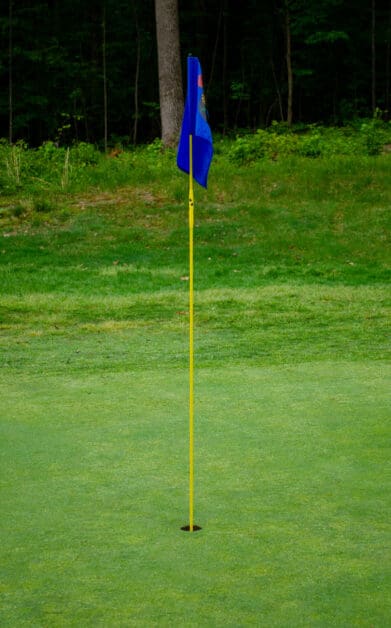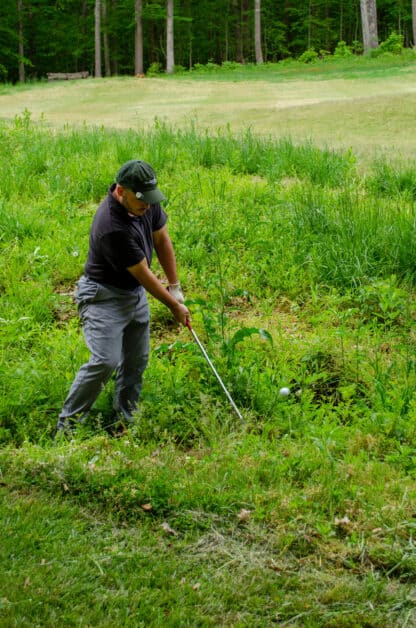Breaking 90 is one of the most sought-after major milestones for golfers. It can be a status symbol for many, and an indication of how much time and effort you’ve put into the game. Furthermore, breaking 90 consistently means that you are an experienced golfer, dedicated to rating your rounds and improving your game.
But what percentage of golfers can break 90 consistently? According to the National Golf Foundation, 26 percent of golfers break 90 regularly on a 18 hole course. Meaning many golfers are unable to accomplish this feet.
But it depends on who you ask and what sources you’re pulling your data from. So keep reading on to find out what percentage of golfers out there can actually break that mythical score.

USGA Stats on Percentage of Golfers Break 90
According to the United States Golf Association, a whopping 73.4 percentage of golfers can break 90. That means the vast majority of golfers are shooting in the 80s regularly. That oft-quoted percentage seems to confuse and intimidate a lot of amateur and recreational golfers. If so many of your peers are breaking 90, what’s wrong with you?
In a word, nothing—so let’s take a closer look at this statistic. While the USGA’s data is technically correct, it needs to be put into context. The study measures how many players report a handicap of 17.9 or better. But remember, a handicap is a little different from your score in relation to par.
These stats also only take into account data reported by golfers who are a part of a USGA-compliant golf club. Besides, most golfers who are shooting over 90 are not keeping a handicap and are far less likely to be a member of a USGA-compliant golf club. Additionally, most amateur and recreational golfers are not breaking 90 regularly. The majority of golfers who are keeping a consistent handicap are more seasoned and therefore more likely to be breaking 90.
My Golf Spy and The Grint’s Stats on Breaking 90
According to a study conducted by My Golf Spy and The Grint, 49 percentage of golfers break 90. While that’s less than the USGA study, let’s put that into context as well. This data was captured using a sample of 15,000 golfers who fall under the following two categories: they must be a part of a USGA compliant golf club, and they must have uploaded at least 5 or more scores with the GPS and Handicap tracker app The Grint.
Again, much like the USGA statistics, golfers who are regularly tracking their scores are probably scratch golfers, rather than your average recreational golfer. Golfers using an app like The Grint, are likely more tech-savvy and therefore more likely to skew younger than the general population of golfers. Younger golfers also tend to be more athletic, and less likely to be injured in a way that could negatively affect their shots.
The National Golf Foundation’s Stats on Breaking 90
According to the PGA.com’s report of the National Golf Foundation, only 21 percentage of golfers get an average score of 80-89, which means only 26 percentage of golfers break 90. The NGF stats also take into account the difficulty of the course, and the population studied includes those who have taken fewer lessons than the seasoned golfers included in the USGA, along with My Golf Spy and The Grint reports.
Golf Blogger Statistics On Breaking 90
Golfblogger reports an even lower number of golfers breaking 90. According to their 2010 study, only 21 percentage of golfers break 90. There also seems to be a marked improvement in golfers’ scores over the years, which might contribute to the higher percentage of golfers shooting below 90 throughout the decades.

Golfblogger also seems to have quite a few qualms about how USGA data is collected and reported. Remember, these scores are self-reported and therefore rely on the players to be totally honest about their scores and strictly follow all game regulations. Now while we know golfers are mostly honest people, they’re still people.
People often lie and embellish for the sake of their egos or accidentally misreport their shots because of human error. This is, of course, conjecture, but it could account for why all of these statistics are so different.
Tips to Breaking 90 For Your Average Score
Here are a few tips on how you can improve your scoring quickly to get you moving towards that average score being under 90.
Short Game Scoring
Many golfers spend too much of their practice time on the driving range or playing with their buddies. But a big key to improving your golf scores is to put in the work on your short game.
If you talk to Golfers who can break 90, break 80 and shoot a 78 or even break 70 you will notice a trend that the lower their average score is or the lower their usga handicap. The more time they spend on the putting green. While those that struggle with breaking 100 consistently spend more time on the driving range.
Spend time working on short putts. Practicing making putts from inside 5 feet. This will help reduce 3 putts during your rounds and will help you get up and down more often when you do miss the green. If you can make 3-4 more short putts per round, that is a huge change in your average scoring.
Staying Relaxed and Calm
The ability to not be rattled when you hit a bad shot can greatly reduce your golfing score. Amateur golfers regularly hit crooked shots and miss easy putts. But its the ones who don’t let it ruin their round that find they are able to break 80, break 90 and break 100 more consistently.

Taking deep breaths after a miss. Or remembering all the work you put into your short game to help you get up and down from that bunker, will greatly increase your chance at lower scores.
Play With Purpose More Often
Just getting on the golf course more isn’t the simple answer. Golfers can break 90 once or twice, but if you don’t put in intentional practice accomplishing that, the regularity of it won’t come.
Practice playing each hole like it’s important and experiencing the work it takes to lower your score each round. You will find that the practice alone will translate to more important rounds later on.
So What’s The Truth?
The truth is that no one truly has concrete data on what exact percentage of golfers actually break 90. Unless someone conducts a centralized, non-prejudiced study that includes players of all levels and accounts for course difficulty and slope, we may never really lock down that answer for sure. There seem to be a few things we know for sure, however.
The key to reaching that milestone of breaking 90 is practice, practice, practice. It takes at least 1-5 years on average for a player to break 90. Taking lessons, playing a conservative, less aggressive game, and limiting major errors can also help you achieve this goal.
At the end of the day, however, experience seems to be the most important quality that helps golfers shoot under 90. So get those games in, be patient with yourself, and don’t forget to have fun out there on the green.
- Should Tee Boxes Be Level? - January 23, 2024
- 3 Hybrid Distance - November 15, 2023
- Innovations in Golf Mobility: An In-depth Review of Top Golf Scooters - October 12, 2023
